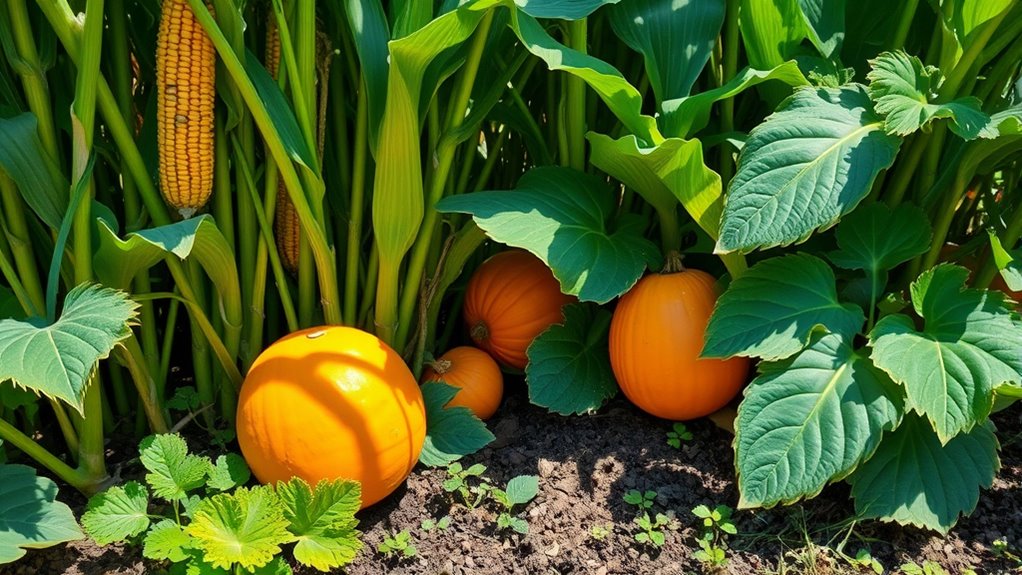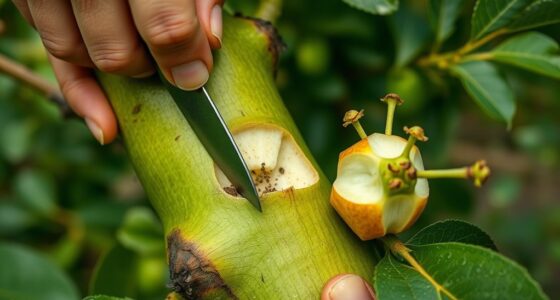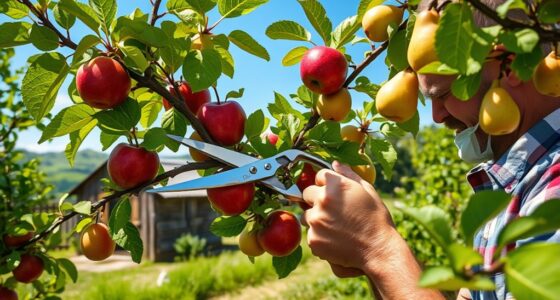Intercropping sweet corn and pumpkins helps suppress weeds by creating dense canopies that shade out weeds and reduce sunlight reaching the soil surface. To succeed, select varieties with compatible growth habits and plant pumpkins around 3-4 feet apart around the corn rows. Proper spacing, timing, and careful management of water and nutrients support healthy growth and maximize weed suppression. For more tips on establishing a productive intercrop system, keep exploring the key strategies.
Key Takeaways
- Plant pumpkins around sweet corn to create dense ground cover, shading soil and suppressing weed growth.
- Use pumpkin varieties with sprawling habits to cover soil quickly and outcompete weeds.
- Space pumpkins 3-4 feet apart and interplant within corn rows for effective canopy coverage.
- Sow pumpkins after establishing corn to reduce root competition and maximize weed suppression.
- Maintain proper spacing and timely planting to ensure dense canopy formation and minimize weed emergence.
Advantages of Combining Sweet Corn and Pumpkins in the Field
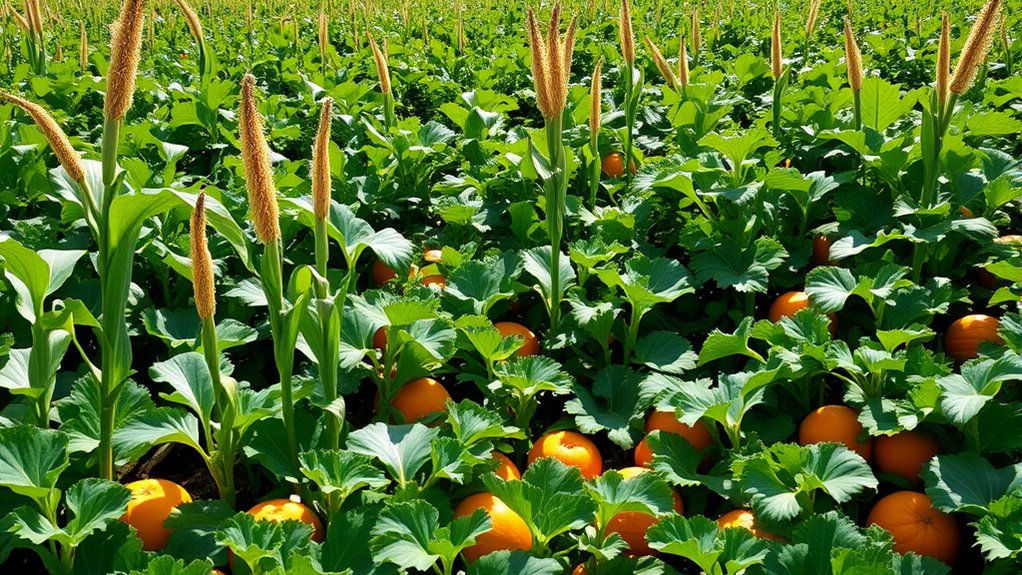
Combining sweet corn and pumpkins in the same field offers several practical benefits that can improve your overall harvest. One key advantage is enhanced pest management; pumpkins can attract beneficial insects that prey on common pests, reducing the need for chemical controls. Additionally, intercropping promotes better soil health by diversifying root structures and nutrient use, which helps prevent soil degradation. Pumpkins’ sprawling vines cover the ground, minimizing weed growth and reducing soil erosion. This natural ground cover also maintains moisture levels and improves soil aeration. Overall, this combination creates a more resilient and sustainable system, encouraging healthier plants and higher yields. Implementing this method allows you to manage pests more effectively while maintaining vibrant soil conditions.
Selecting the Right Varieties for Intercropping

When choosing varieties for intercropping, you need to consider their growth habits to ensure they don’t compete too aggressively. Picking sweet corn and pumpkin varieties that mature around the same time helps maximize space and yield. By matching their development, you set the stage for a successful and productive intercropping system. Additionally, selecting appropriate tuning options can enhance crop resilience and overall productivity. Understanding plant growth dynamics can further improve the compatibility and success of your intercropping efforts. Recognizing the importance of crop compatibility can lead to better yield outcomes and resource use efficiency. Incorporating companion planting principles can also support pest management and soil health, contributing to a more sustainable crop system. Considering hybrid varieties may also improve adaptability to local conditions and increase overall yield stability.
Compatible Growth Habits
Choosing the right varieties for intercropping sweet corn and pumpkins is essential because their growth habits directly affect how well they coexist in the same space. You want varieties with compatible growth habits—pest management and pollination dynamics depend on this. Select sweet corn that grows upright and reaches a manageable height without overshadowing pumpkin vines, which tend to sprawl. Pumpkins should have a spreading habit that doesn’t compete aggressively with corn for sunlight or nutrients. This minimizes pest issues by reducing hiding spots and encouraging better airflow, which deters diseases. Additionally, compatible growth habits support effective pollination, ensuring good fruit set for both crops. By choosing varieties with these traits, you promote a balanced, productive intercrop that suppresses weeds naturally. Understanding growth habit compatibility is key to optimizing both crop performance and weed suppression in intercrop systems. Choosing varieties with similar growth rates can help maintain a harmonious balance between the crops throughout the growing season. Incorporating plant spacing considerations also plays a crucial role in fostering healthy growth and minimizing competition.
Optimal Maturity Timing
Selecting varieties with compatible maturity timings is essential for successful intercropping of sweet corn and pumpkins. Maturity synchronization ensures both crops reach harvest at appropriate times, preventing crop competition and maximizing yields. By choosing pumpkin varieties that mature around the same time as sweet corn, you can coordinate harvest timing effectively. This alignment reduces labor overlaps and simplifies management, ensuring neither crop dominates or is stunted. Keep in mind that early-maturing pumpkins may be ready before sweet corn, so select varieties that complement each other’s growth cycles. Proper maturity timing also helps maintain weed suppression, as the crops can shade the soil simultaneously. Ultimately, selecting the right varieties based on their maturity timings optimizes your intercropping system’s success.
Planting Layouts and Spacing Considerations
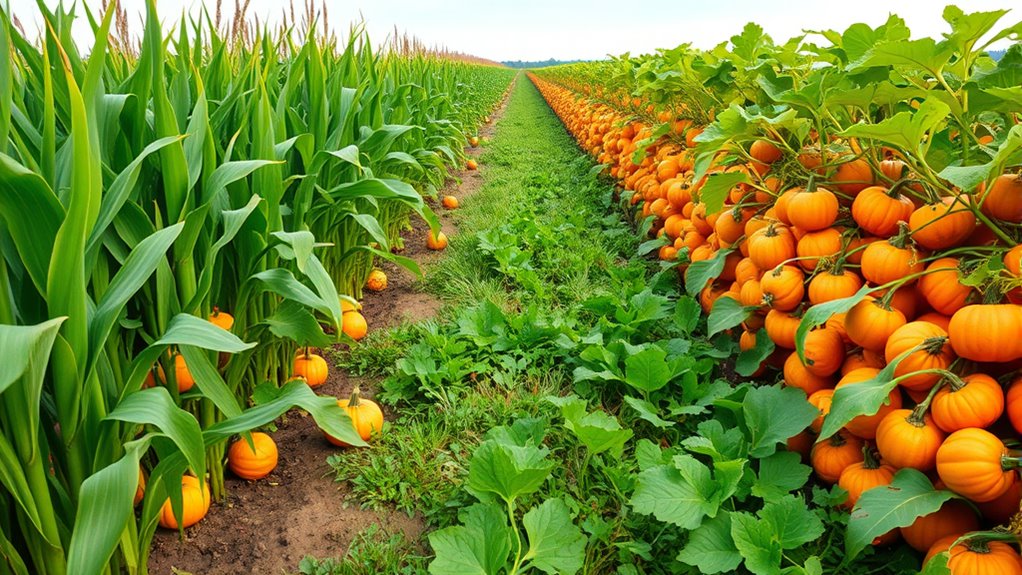
Have you considered how planting layouts and spacing impact the success of intercropping sweet corn and pumpkins? Proper spacing guarantees each crop receives adequate sunlight, air circulation, and nutrients, reducing disease risk and pest issues. For effective companion planting, position pumpkins around sweet corn to maximize weed suppression and pest management. Keep pumpkins spaced about 3 to 4 feet apart in a grid or row pattern, with corn rows about 30 inches apart. This setup allows pumpkins to spread without overshadowing the corn or competing for resources. Maintaining adequate spacing also makes it easier to manage pests and monitor plant health. Thoughtful layout choices optimize yield, improve weed suppression, and promote a healthy, balanced ecosystem for your intercropping system. Additionally, implementing noise reduction technology in nearby structures can minimize disruptions during planting and maintenance activities. Considering local climate conditions can further enhance the success of your intercropping strategy. Proper plant spacing not only supports healthy crop development but also can influence the effectiveness of natural pest deterrents and weed suppression methods. Incorporating biodiversity principles into your layout can further strengthen ecosystem resilience and pest control. Recognizing the importance of soil health and nutrient management can also significantly improve crop performance and sustainability.
Timing and Sequence for Optimal Growth

Timing and sequence are key to successful intercropping; getting the order right can boost growth for both crops. You should plan your planting strategy to match each plant’s ideal timing window. Coordinating growth stages ensures that sweet corn and pumpkins support each other rather than compete. Understanding growth stages is essential for optimizing the benefits of intercropping. Additionally, recognizing the competition for resources during critical development periods helps prevent crop stress and maximize yields. Being aware of seasonal variations can further enhance the success of your planting schedule. Proper timing also helps maintain effective air circulation, reducing the risk of disease and promoting healthier plant development. Adjusting planting dates based on local climate conditions can further improve crop compatibility and overall productivity.
Planting Sequence Strategy
To guarantee the best growth and yield, you should carefully plan the planting sequence for intercropping sweet corn and pumpkins. Start by planting sweet corn first, allowing it to establish roots and minimize root competition with pumpkins. Pumpkins can then be sown after corn has grown for a few weeks, reducing pest risks and avoiding early root competition. Proper timing ensures both crops develop fully, optimizing space and resources. Use the following table to visualize the sequence:
| Step | Action |
|---|---|
| 1 | Plant sweet corn first, early season |
| 2 | Monitor corn growth |
| 3 | Sow pumpkins after corn establishment |
| 4 | Ensure pumpkins grow without root competition |
| 5 | Manage pests early, targeting specific stages |
This strategy promotes healthy growth and suppresses weeds naturally. Additionally, selecting the right planting sequence can maximize resource use and improve overall crop health. Recognizing and timing the growth stages of each crop can further enhance intercropping success, especially when considering crop management practices. Using proper timing according to each crop’s needs can also help reduce pest and disease issues, leading to a more sustainable system. Incorporating companion planting principles can further support crop health and weed suppression in this intercrop system.
Optimal Timing Windows
Choosing the right time windows for planting sweet corn and pumpkins is essential to maximize growth and yield. Timing influences not only crop development but also pest management and crop rotation strategies. Plant sweet corn early enough to establish quick canopy cover, which suppresses weeds and reduces pest habitats. Follow with pumpkin planting when corn is nearing maturity to avoid competition and pests. Proper timing ensures pumpkins don’t interfere with corn’s growth cycle, helping maintain effective pest control. Also, scheduling plantings to align with crop rotation plans prevents disease buildup and maintains soil health.
- Plant corn early to establish quick weed suppression and pest management
- Time pumpkin planting to avoid overlapping growth stages
- Use crop rotation timing to reduce pest issues and improve yields
Growth Stage Coordination
Coordinating the growth stages of sweet corn and pumpkins guarantees both crops reach their peak productivity without competing for resources. To do this effectively, you should time planting so pumpkins establish early, providing weed suppression before sweet corn reaches critical growth phases. Regular soil testing helps determine nutrient levels and pH, guiding your fertilization schedule to support synchronized growth. Timely pest management is essential; monitor pests that may affect either crop during vulnerable stages and act promptly. By aligning planting and development stages, you minimize competition for sunlight, water, and nutrients. This coordination ensures both crops thrive, maximizing yields and simplifying weed suppression efforts. Proper timing and resource management ultimately lead to a healthier, more productive intercropping system.
Managing Water and Nutrients for Dual Crops

Managing water and nutrients effectively is essential when growing sweet corn and pumpkins together, as both crops have distinct needs that can influence each other’s growth. You should start by conducting soil testing to determine nutrient levels and moisture content, ensuring proper adjustments. Proper irrigation helps prevent water stress for either crop, especially during critical growth stages. To optimize nutrient use, consider side-dressing or mulching to retain soil moisture and reduce nutrient runoff. Keep pest management in mind, as healthy plants resist pests better and require fewer interventions. Additionally, monitor soil moisture regularly, adjusting watering schedules accordingly. Remember, balanced watering and nutrient management promote strong growth, suppress weeds, and improve overall yield for both crops.
Strategies for Weed Suppression Through Canopy Coverage

Effective weed control in intercropping systems relies heavily on maximizing canopy coverage to shade out weeds and limit their growth. By planting sweet corn and pumpkins together, you create a dense canopy that suppresses weed emergence naturally. This reduces the need for herbicides and simplifies pest management by limiting weed habitat for pests. Ensuring good soil fertility supports healthy, vigorous crops that quickly establish dense foliage, enhancing shading effectiveness. Proper spacing and timely planting are key to achieving ideal canopy cover. A well-structured canopy not only suppresses weeds but also conserves soil moisture, reducing erosion and maintaining soil health. These strategies work together to create a sustainable system that minimizes weed pressure while supporting crop growth and overall soil fertility.
Monitoring and Maintaining Healthy Intercropped Fields

Regular monitoring is essential to guarantee your intercropped sweet corn and pumpkins stay healthy and productive. You need to keep an eye on signs of pest management issues and conduct soil testing regularly to maintain ideal conditions. Early detection of pests allows you to act swiftly, preventing damage and reducing the need for chemical controls. Soil testing helps you understand nutrient levels and pH, guiding your fertilization schedule for healthy growth.
- Check for pest infestations on leaves and stems frequently
- Schedule soil tests every few weeks to monitor nutrient levels
- Observe plant development to spot stress signs early
Harvesting and Post-Harvest Practices for Intercropped Systems

Timely harvesting is essential to guarantee your intercropped sweet corn and pumpkins reach their peak flavor and quality. Harvest the sweet corn when kernels are full and milk stage is just about to dry, and pick pumpkins at full color and mature size. After harvest, focus on managing post-harvest residue to prevent disease and pests. Proper equipment cleaning is vital; thoroughly wash tools and machinery to remove plant debris and residue. This reduces contamination risks and maintains equipment longevity. Use the table below to guide your post-harvest practices:
| Step | Action |
|---|---|
| Harvest Timing | Pick at peak maturity |
| Handling | Handle gently to avoid damage |
| Post-harvest residue | Remove and dispose properly |
| Equipment cleaning | Clean all tools and machinery thoroughly |
| Storage | Store crops in cool, dry conditions |
Frequently Asked Questions
How Does Intercropping Affect Pest and Disease Management?
You might notice that pest habitat becomes more diverse, which can reduce pest populations by disrupting their preferred environments. Intercropping can also slow disease spread because it creates physical barriers and enhances airflow, limiting pathogen movement. By diversifying your crops, you actively manage pests and diseases, making it harder for them to thrive and spread. This strategy promotes healthier plants and reduces your reliance on chemical controls.
What Are the Economic Benefits of Intercropping Sweet Corn and Pumpkins?
You’ll find that intercropping sweet corn and pumpkins boosts economic profitability by maximizing land use and reducing input costs. It also offers market diversification, allowing you to sell different crops and reach wider audiences. This strategy can lead to higher overall income, lower risks from crop failure, and more stable revenue streams. By growing both, you enhance your farm’s resilience and profitability, making your operation more sustainable and profitable in the long run.
Can Intercropping Increase Overall Farm Biodiversity?
It’s ironic how planting fewer crops could boost biodiversity, but intercropping actually does. By combining sweet corn and pumpkins, you promote plant diversity, attracting beneficial insects and supporting a healthier ecosystem. This integrated approach creates a more resilient farm environment, encouraging beneficial insect populations that naturally control pests. So, yes, intercropping can increase your farm’s overall biodiversity, making it more sustainable and less reliant on chemical interventions.
What Are the Challenges of Managing Two Crops Simultaneously?
Managing two crops simultaneously presents challenges like crop competition, where one might outgrow or overshadow the other, affecting growth and yield. You also need to coordinate harvest timing carefully, ensuring neither crop is compromised. This requires close monitoring, adjusting practices, and sometimes making tough decisions to balance resources. Staying attentive helps you maximize benefits and minimize issues, ensuring both crops thrive and your overall farm productivity improves.
How Does Intercropping Influence Soil Health Over Time?
Think of your soil as a thriving city; intercropping acts like a bustling marketplace, enriching soil nutrient levels and microbial diversity over time. As you plant sweet corn and pumpkins together, roots interact and share resources, boosting soil health. This dynamic balance improves nutrient cycling, enhances microbial diversity, and maintains soil robustness. Over time, your soil becomes more resilient, supporting healthy crops and reducing the need for chemical inputs.
Conclusion
By intercropping sweet corn and pumpkins, you’ll transform your field into an unstoppable weed-suppressing powerhouse. Imagine a jungle so dense that weeds dare not survive—your crops thrive like never before, yielding bumper harvests with minimal effort. This dynamic duo isn’t just a planting strategy; it’s your secret weapon against weeds, pests, and poor yields. Get ready to revolutionize your farming game and witness nature’s most powerful collaboration unfold right in your fields!

